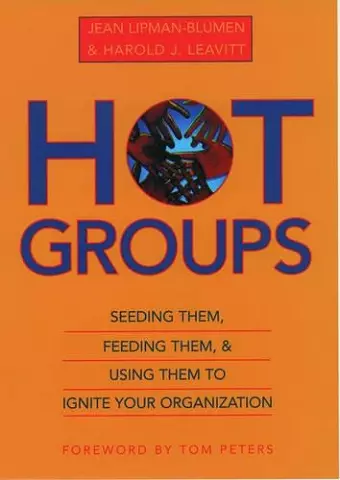Hot Groups
Seeding Them, Feeding Them, and Using Them to Ignite Your Organization
Harold J Leavitt author Jean Lipman-Blumen author
Format:Hardback
Publisher:Oxford University Press Inc
Published:17th Jun '99
Currently unavailable, and unfortunately no date known when it will be back

Many corporations, in their attempt to create innovative products and services, have focused on the concept of building teams. While many groups fizzle, on rare occasions the members of a group will experience an extraordinary eruption of excitement, transcending an organization's rigid confines to achieve astonishing results. These individuals, say Jean Lipman-Blumen and Harold J. Leavitt, are lucky enough to be members of a "hot group," a phenomenon they lucidly and enthusiastically describe in their ground-breaking new book Hot Groups. A hot group is not a name for a newfangled team, task force, or committee. Rather, a hot group is defined by a distinctive state of mind coupled with a style of behavior that is intense and sharply focused on its ultimate goal. Stretching themselves beyond their own expectations, members of a hot group plunge into enterprises that have the potential to change, even ennoble, their own and others' lives. Neither trendy fabrication nor new management fad, hot groups have existed since the dawn of civilization, perhaps invigorating groups of cavemen to hunt together furiously for food before winter's approach. Today, examples of hot groups abound in territories such as Silicon Valley, where impassioned people have blazed paths through the burgeoning computer industry. Consider the hot group that created the original Macintosh and revolutionized the personal computer market. John Sculley, who joined Apple in the early 1980s, described a "magnetic field" that surrounded the Macintosh hot group members, and Bill Gates, Microsoft's mastermind, reported that a hot programming group to which he once belonged "didn't obey a 24-hour clock." Instead, they programmed for days at a time, pausing only to eat and talk about software with fellow programmers. Here also are examples of hot groups at work in other industries: the individuals that created the blockbuster TV drama "Hill Street Blues"; the Navy and civilian personnel that transformed a standard cruiser into a guided missile cruiser in less than 12 months; and even the ad hoc crisis management group advising President John F. Kennedy during the Cuban Missile crisis. Indeed, the inspiring case studies found throughout Hot Groups illustrate that well-nourished hot groups can profoundly transform any type of organization. Still, Lipman-Blumen and Leavitt recognize the risks inherent in loosening an organization's structural soil enough...
"Captures the attributes of intense, task dominated teams that energize both individual and organizational effectiveness in doing what han't been done before." "Jean Lipman-Blumen and Hal Leavitt take the reader into the world of 'hot groups', a world they know so well but remains allusive to most of us. Lipman-Blumen and Leavitt dissect the inner workings of 'hot groups' with their boundless energy, creativity and crystal clear sense of mission. This book will drive most readers to search for their own 'hot group' experience, whether it's to be found in their work, community or family. An extraordinarily relevant book for our dynamic but chaotic times." --Robert C. Fisher, Schroder & Co. Inc. "Hot Groups makes a passionate case for injecting strategic disorder into disciplined organizations. Packed with information, it is clearly written, superbly organized and entirely original. Anyone who has an interest in fostering quick and real organizational change to confront a rapidly transforming world will want to read it and refer to it." --Barry Munitz, The J. Paul Getty Trust "A new buzz term has just been spawned. It's called "hot groups" and was coined by Jean Lipman-Blumen and Harold J. Leavitt in their recently published book.... A hot group is a group that is totally passionate about a task...Although unnamed until now, hot groups have always existed. But, with a marked demand for innovation and new products and technology, they're more important than ever."--Bob Weinstein, The Washington Times "Drawing on decades of research and experience working with groups and organizations s throughout the world, these renowned authors have written a provocative book detailing how small, egalitarian, disordered "hot groups" can bring about revolutionary change. Essential reading for senior executives, managers responsible for bringing about organizational change, and business scholars."--Social & Behavioral Sciences "Drawing on decades of research and experience working with groups and organizations throughout the world, these renowned authors have written a provocative book detailing how small, egalitarian, disordered 'hot groups' can bring about revolutionary change.... This book's 16 well-written and readable chapters are packed with keen insights and practical suggestions.... Essential reading for senior executives, managers responsible for bringing about organizational change, and business scholars."--Choice
ISBN: 9780195126860
Dimensions: 241mm x 162mm x 27mm
Weight: 572g
320 pages